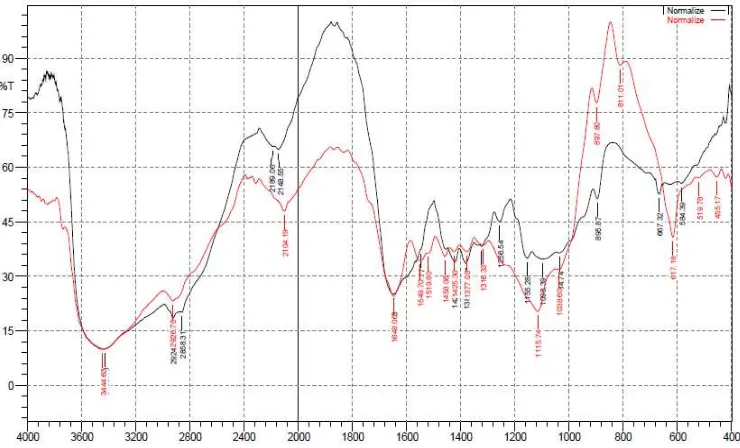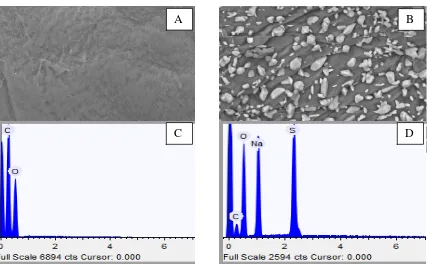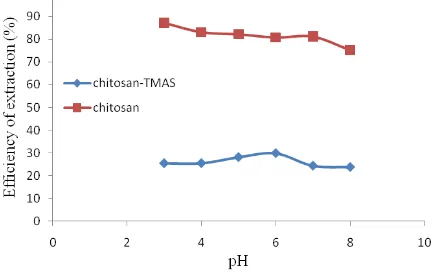The journal homepage www.jpacr.ub.ac.id ISSN : 2302 - 4690
47
Extraction of Copper(I) Thiosulfate by Modified Chitosan
Okky Anggraito1*, Akhmad Sabarudin1 and Ani Mulyasuryani1
1
Department of Chemistry, Faculty of Science, Brawijaya University Jl. Veteran Malang 65145, East Java – Indonesia
*Corresponding Author: [email protected]
Received 20 December 2013; Accepted 13 February 2014; Revised 10 April 2014; Published online for edition May-August 2014
ABSTRACT
Chitosan is one of non-toxic natural biopolymer and abundance in nature. Chitosan have two active sites such as amine and hydroxyl groups. Amine groups (-NH2) in chitosan can be modified into secondary amine (-NHR). In this research, copper was dissolved as copper(I) thiosulfate as anion complex (Cu(S2O3)23-) and chitosan was modified by trimethylamine sulfur trioxide (TMAS). One of hydrogen atom in –NH2 was substituted by
–SO3Na. The result of this research, the modified chitosan was identified by FT-IR. FT-IR spectra gave characteristic band at 3600-3200 cm-1 (O-H and N-H); 1648 cm-1 (C=O); 1115,74 cm-1 (S=O) and 617,18 cm-1 (N-S). The result of surface analysis using SEM and TEM showed that the surface morphology of sulfated chitosan as a result of modification is different in comparison with chitosan. Based on chitosan, pH extraction was adjusted to pH 3 until 8. After optimum pH of extraction was obtained then re-extraction was done by using thiosulfate solution at 0.05 ; 0.10 ; 0.50 ; and 1.00 M. Extraction and re-extraction of copper(I) thiosulfate was analyzed by Atomic Absorption Spectrophotometer (AAS). The highest efficiency extraction using modified chitosan and chitosan respectively at pH 3 and 6. The efficiency re-extraction using modified chitosan and chitosan respectively 100% and below 100%.
Keywords : Chitosan, modified chitosan, extraction, re-extraction, and anion complex.
INTRODUCTION
Chitosan is one of polysacaride which is obtained from chitin deacetylation. Chitosan was obtained by heating up chitin in reflux condition with concentrated potassium hydroxide [1]. Chitosan is not soluble in water, but it can dissolve in acetic acid at 1% concentration at pH 4 [2]. Chitosan have chemical properties such as non-toxic polymer, enzymatically biodegradable, and biocompatible polymer [3]. Therefore, chitosan has prospective application such as pharmacy, drug delivery, cosmetics, and waste water treatment [2,4]. Chitosan have amine and hydroxyl groups as the active sites, so it can form chelat complex with various metal [5]. The pKa of Chitosan is 6.5 [6]. Amine groups in chitosan will protonated at pH < 6.5 [6].
The journal homepage www.jpacr.ub.ac.id ISSN : 2302 - 4690
48
Copper(I) thiosulfate as anion complex can be extracted by electronic interaction. In this research, the effect of pH studied at pH 3 until 8. The range of pH used to change –NH2 in chitosan become –NH3+ [1]. Based on chitosan, in modified chitosan the active sites will modified from –NH2 become –NHR. The change of active sites will have effects for extraction copper(I) thiosulfate.
Recently, there has been a growing interest in the chemical modification of chitosan to generate a new biofunctional materials, improve its solubility and widen its application [2,4]. Amine groups in chitosan is reactive, so it is easy to modified into its derivatives. Amine groups can be modified into secondary, tertiary, and quartenary amine groups [9]. Sulfated chitosan is the modified chitosan that change primary amine group into secondary amine group. Sulfated chitosan was prepared by using N,N-dimethyl formamide (DMF) and sulfur trioxide [4]. Another investigation have been reported by different method. Sulfated chitosan was prepared by trimethylamine sulfur trioxide (TMAS) and sodium carbonate [10]. Sulfated chitosan and its derivatives can be used for blood anticoagulant, hemagglutination inhibition activity, and adsorbing metal ions [4].
In this research, chitosan was modified with trimethyl amine sulfur trioxide (TMAS). The modification occured because of substitution one of hydrogen atom in –NH2 by –SO3Na. The aim of this paper is to compare sulfated chitosan and chitosan by its characteristic. Fourier Transform Infrared spectroscopy (FTIR) was used to study the characteristic of sulfated chitosan [11]. The surface structure of sulfated chitosan was identified by Scanning Electron Microscopy (SEM) and Transmission Electron Microscopy (TEM).
EXPERIMENTAL Materials
Chemicals used in this study are chitosan, sodium carbonate, trimethylamine sulfur trioxide (TMAS) complex, ammonium thiosulfate (Merck) and deionized water.
Apparatus
The apparatus used in this study include hotplate, glassware, electric shaker, thermometer, oven, motor rotary, Scanning Electron Microscopy (Hitachi TM-3000), Transmission Electron Microscopy (JEM-1400), Fourier Transform-Infrared Spectrometer (Shimadzu 8400S).
Modification of Chitosan
Modified chitosan was prepared based on the method reported by Ho-Yi Cheng [5]. Sodium carbonate solution was made by diluting 7.170 grams of sodium carbonate into 80 mL of deionized water. 5 grams of chitosan was suspended in sodium carbonate solution. This suspension was added with 13.480 grams of trimethylamine sulfur trioxide complex while being stirred and heated up at 65 oC. The reaction was carried out for 40 h. The mixture was cooled down to laboratory temperature and dialyzed against deionized water and then it was dried to obtain sulfated chitosan.
Extraction Copper(I) thiosulfate
The journal homepage www.jpacr.ub.ac.id ISSN : 2302 - 4690
49
measured using atomic absorption spectrophotometer (AAS). The treatment is carried out from pH 3 to 8. The same procedure is done by replacing the solid phase with chitosan
Re-extraction Copper(I) thiosulfate
Dry the solid phase after extraction process and poured in 50 mL Erlenmeyer flask and add 10 mL of thiosulfate solution 0.01, 0.05, 0.1, 0.50, and 1.00 M. The mixture was shake at 150 rpm for 2 hours. Solid phase was filtered using filter paper and the absorbance was measured using atomic absorption spectrophotometer (AAS).
RESULT AND DISCUSSION Modification of chitosan
Chitosan was modified using TMAS. Chitosan and it’s modified was analysis using FT-IR, SEM and TEM. The infrared spectrum of chitosan and sulfated chitosan were shown in Figure 1. The wave number of modified chitosan [KBr pellet (υmax/cm-1)]: 3600-3200 cm-1 (O-H and N-H); 1648 cm-1 (C=O); 1115.74 cm-1 (S=O); and 617.18 cm-1 (N-S). The existence of S=O and N-S vibration indicate that –SO3Na group have bonded with chitosan. This data identify the formation of chitosan-N-sulfate.
The surface morphology of modified chitosan was also observed by SEM as shown in Figure 2. Chitosan without TMAS have smooth surface and sulfur has no sign in this polymer. The modification of chitosan with TMAS can change surface structure into rough surface and sulfur exists in this polymer. The percentage of element in chitosan was observed by EDX in SEM. The major contributors in EDX spectrum are sulfur, sodium, and oxygen. The high percentage of the element is due to the addition of TMAS and Na2CO3 reagent. Based on Figure 2(D), the addition of TMAS increases the percentage of sulfur up to 8.70%. EDX-SEM confirmed the presence of sodium in sulfated chitosan is 12.43%. Sodium was detected because of Na2CO3 addition in modification process. Sodium interacted with sulfur trioxide that was shown in Figure 2(B).
The journal homepage www.jpacr.ub.ac.id ISSN : 2302 - 4690
50
Figure 2. SEM micrograph of (A) chitosan and (B) sulfated chitosan (C) EDX-system of chitosan (D) EDX-system of sulfated chitosan
Figure 3. TEM micrograph of chitosan: (A) chitosan 60.000X, (B) modified chitosan 60.000X, (C) chitosan 150.000X, (D) modified chitosan 150.000X.
Chitosan and sulfated chitosan were observed by TEM to identify their depth structure. Figure 3 shows no difference between sulfated chitosan and chitosan when analyzed using TEM. This is due to the starting material of sulfated chitosan is pure chitosan,
C A
B
B
C D
A
The journal homepage www.jpacr.ub.ac.id ISSN : 2302 - 4690
51
no modification. Figure 3 also shows that chitosan and sulfated chitosan are free from metal especially copper. If there is copper in chitosan, there will be many black dots.
Extraction of Copper(I) thiosulfate
The journal homepage www.jpacr.ub.ac.id ISSN : 2302 - 4690
52
copper(I) thiosulfate using modified chitosan is only ion exchange (electronic interaction). Copper that extracted in chitosan’s active sites cannot be re-extraction 100%. This is one indication that the mechanism of extraction of copper(I) thiosulfate using chitosan is not only by electronic interaction but also by complexes interaction.
CONCLUSION
Based on this research, it can be concluded that chitosan have been succeeded modified with TMAS into modified chitosan. modified chitosan gave wave number 3600-3200 cm-1 (O-H and N-H); 1648 cm-1 (C=O); 1115.74 cm-1 (S=O); and 617.18 cm-1 (N-S). The modified chitosan has a lower ability for the adsorption of copper(I) thiosulfate compared to chitosan. The optimum pH extraction of copper(I) thiosulfate highest using the modified chitosan and chitosan respectively at pH 6 and 3. The mechanism extraction of copper(I) thiosulfate using modified chitosan is only electronic interaction while the mechanism extraction of copper(I) thiosulfate using chitosan are electronic interaction and complexes interaction.
ACKNOWLEDGEMENT
The authors would like to thank to BPKLN (Biro Perencanaan dan Kerjasama Luar Negeri), The Ministry of Education and Culture of Indonesia, for research funding through the Fast Track Program.
REFERENCES
[1] D. Jansson, Materials Engineering, Tampere University Technology, 2010. [2] N.M. Alves, J.F. Mano, Int. J. Biol. Macromol., 2008, 43, 401-414.
[3] P.K. Dutta, J. Dutta, V.S. Tripathi, J. Sci. Ind. Res., 2004, 63, 20-31.
[4] R. Jayakumar, N. Nwe., S. Tokura, H. Tamura, Int. J. Biol. Macromol, 2007, 40, 175-181.
[5] J. Guzman, I. Saucedo, J. Revilla, R. Navarro, E. Guibal, Int. J. Biol. Macromol, 2003, 33, 57-65.
[6] T.A. Sonia, C.P. Sharma, Adv. Polym. Sci., 2011, 243, 23-54.
[7] A. Mulyasuryani, Anna, R., Arie,S, Indonesian Journal of Chemistry, 2010, 10, 162-166.
[8] A. Mulyasuryani, Indonesian Journal of Chemistry, 2007, 7, 284-288. [9] M.J.Z. Mehr, Iran. Polym. J., 2005, 14, 235-265.
[10] Y-C Ho, Wu S-J., Mi F-L., Chiu Y-L., Yu S-H., Panda N., Sung H-S, Bioconjugate Chem., 2010, 21, 28-38.
[11] Md. M. Islam, S. Md. Masum, M.M. Rahman, Md.A.I. Molla, A.A.Shaikh, S.K. Roy,


